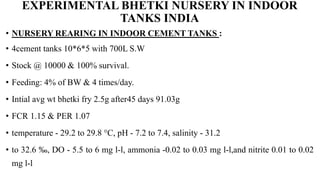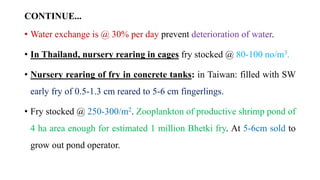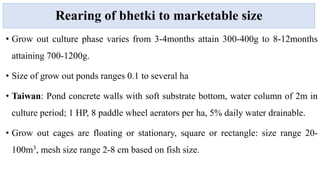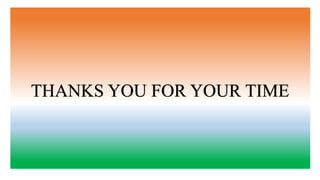Asian sea bass culture
- 1. Asian sea bass Lates calcarifer culture Phylum : Chordata Clas : Pisces Order : Percomorphi Family : Centropomidae Genus : Lates Species : Lates calcarifer (Bloch, 1970)
- 2. INTRODUCTION • Asian seabass is also called as giant perch (centropomidae) and in India it is called as “Bhetki”. • Highly euryhaline habit enables culture in F W & S W condition & living in estuaries. • Distribution: found in the littoral water of indo- West Pacific region extending from Iran to Australia, its profitable culture carried out in SEA countries especially in Thailand & Taiwan.
- 3. Conti,,, • Hatchery production of Bhetki fry industry established in Thailand, its excess fry exporting to other countries also in Taiwan. • Dr. Thirunavukarasu said that today the sea bass production in the India was only 25,000 tonne. • CIBA supplied us 10,000 sea bass fishlings free of cost, and we were able to sell 3,600 of them after three months for Rs. 47,500.
- 4. CONTINUE… Major problems during Bhetki culture are, 1. Predominant cannibalistic during young stages (1-20 g). 2. Its depends on high protein rate or on trash fish which is staple diet of poor in developing countries. 3. Unpredictable wild fry availability, in India fry availability abundant in East coast than West coast. Importance: In shrimp farmers turning to next most lucrative finfish sp. Lates calcarifer & other sp.
- 5. ASIAN SEA BASS CULTURE CYCLE
- 6. Nursery rearing of Bhetki fry • Rearing carried out in earthen ponds, concrete tanks or cages. • Earthen ponds: range 500-2000 m, water depth 50-80 cm and 1 mm screen mesh fitted to inlet & outlet gates to protect fry. • Concrete nursery: usually 300 m2 with muddy bottom & water column of 1 m. Aeration by bubbling air through a blower. • Floating or stationary net cages: with 1 mm mesh (size rise with fish). Nursery size range 3 to 10 m3 easily installed and maintained in rivers, coastal areas or in large ponds in calm water areas free from pollution & menace of biofoulers.
- 8. EXPERIMENTAL BHETKI NURSERY IN INDOOR TANKS INDIA • NURSERY REARING IN INDOOR CEMENT TANKS : • 4cement tanks 10*6*5 with 700L S.W • Stock @ 10000 & 100% survival. • Feeding: 4% of BW & 4 times/day. • Intial avg wt bhetki fry 2.5g after45 days 91.03g • FCR 1.15 & PER 1.07 • temperature - 29.2 to 29.8 °C, pH - 7.2 to 7.4, salinity - 31.2 • to 32.6 ‰, DO - 5.5 to 6 mg l-l, ammonia -0.02 to 0.03 mg l-l,and nitrite 0.01 to 0.02 mg l-l
- 9. Days Temperature pH ± salinity DO Nitrite Ammonia 0 day 29.2± 0.2 7.2±0.1 32.6±0.4 2 5.5±0.58 0.015±0.00 0.02±0.002 15 day 29.8±0.2 7.4±0.2 31.2±0.5 6.0±1.26 0.020±0.004 0.02±0.004 30 day 29.4±0.3 7.2±0.1 32.4±0.2 5.5±0.86 0.015±0.008 0.03±0.002 45 day 29.2±0.2 7.2±0.1 32.6±0.2 5.5±0.14 0.015±0.002 0.02±0.002 Source: (K. K. PHILIPOSE, S. R. KRUPESHA SHARMA, N. SADHU, N. G. VAIDYA AND G. SYDA RAO) Karwar, - 581 301, Karnataka, India *CMFRI , Kochi - 682 018, Kerala, India
- 10. Conti,,, Days Mean ± SE weight (g) Mean length (mm) ± SE ADGR (g) SGR SR FCR (%) BI (kg) PER (%) 15 2.60 ± 0.51 64.19 ± 5.46 0.014 0.59 100 1.50 2.2 0.37 30 5.86 ± 0.68 74.18 ± 6.16 0.21 5.41 100 1.20 32.6 2.10 45 11.50 ± 0.88 91.03 ± 7.18 0.37 5.05 100 1.17 82.4 2.21 Water quality parameters recorded during the nursery rearing of L. calcarifer (K. K. PHILIPOSE, S. R. KRUPESHA SHARMA, N. SADHU, N. G. VAIDYAAND G. SYDA RAO) Karwar Research Centre of Central Marine Fisheries Research Institute, Karwar - 581 301, Karnataka, India *Central Marine Fisheries Research Institute, Kochi - 682 018, Kerala, India
- 11. CONTINUE… • In Thailand, nursery ponds reared size from 1-2.5 cm to fingerling 5-10 cm. • Prior to 2 or 3 weeks stocking newly hatched Artemia nauplii inoculated in to pond @ 0.1g/m2. Artemia nauplii grow to adult within 2 weeks. • Bhetki fry stocked @20-50/m2 best alternative feed to fry finally chopped or ground trash fish @ 100% of fish biomass, twice/day in 1st week & gradually reduced to 60% in 2nd and to 40% in 3rd week.
- 12. CONTINUE... • Water exchange is @ 30% per day prevent deterioration of water. • In Thailand, nursery rearing in cages fry stocked @ 80-100 no/m3. • Nursery rearing of fry in concrete tanks: in Taiwan: filled with SW early fry of 0.5-1.3 cm reared to 5-6 cm fingerlings. • Fry stocked @ 250-300/m2. Zooplankton of productive shrimp pond of 4 ha area enough for estimated 1 million Bhetki fry. At 5-6cm sold to grow out pond operator.
- 13. Rearing of bhetki to marketable size • Grow out culture phase varies from 3-4months attain 300-400g to 8-12months attaining 700-1200g. • Size of grow out ponds ranges 0.1 to several ha • Taiwan: Pond concrete walls with soft substrate bottom, water column of 2m in culture period; 1 HP, 8 paddle wheel aerators per ha, 5% daily water drainable. • Grow out cages are floating or stationary, square or rectangle: size range 20- 100m3, mesh size range 2-8 cm based on fish size.
- 14. Stationary cages for Asian sea bass culture (Kangvankii et al 1986)
- 15. BHETKI GROW OUT IN PONDS • Has vague for > 80 years in south east Asia & Australia carried out in mono or poly culture. Monoculture of Bhetki in ponds: Prior to stocking ponds prepared by sun drying bottom, applying quick lime @ 800-2000 kg/ha and OM @ 300-400 kg/ha. • Rice bran will apply @ 300-350 kg/ha, dilute night soil @ 15 tonnes/ha then pond will filled with brackish water (5-10 ppt), 2m depth. • Secchi disc reading 30 cm in pond water. • Fingerlings 5-6 cm stocked @ 10000-40000/ha fed with fresh trash fish or tilapia <200g size @ 10% biomass in grow out pond. • Yield 10mt/ha. Avg. market size 600g within 4-5 months and 6-7 months in winter in Taiwan with 80% survival.
- 16. • Bhetki with tilapia is best choice as primary crop in poly culture common in Thailand &SEA countries. • Tilapia brood Stock 5000-10000/ha introduced ratio of 1:3 ( M:F) breed after 1or 2 months. bhetki juveniles (5-10cm) 3000-5000 no/ha. • Bhetkiculture in cages: well developed in Thailand, Malaysia, Indonesia, Hongkong and Singapore. Fingerlings stocked 40-50/m3. Stocking Bhetki size(cm) mesh size of cages (cm) 1-2 0.5 5-10 1 20-30 2 >25 4 Bhetki poly culture in ponds
- 17. • Conti… • Fingerlings stocked when attained 50-200g wt then by transferring next cage reduced to 10-20fish/m3 • Feeding in cagesn2times/day chopped fish @ 10% Bw for 1st 2-3 months of stocking then 5%BW once/day.
- 19. conclusion • Sea bass near surface swimming has been expected to as it hungerness it may be due to some other impairment may lead to over feed wastage and higher feed cost. • it is one of major best suited candidate species and few reports from fish farmers from India successfully cultured earned higher profits. • Asian seabass & tilapia best suited in combination with size stage diff erent stocking its early stage require highly animal flesh freshly.
- 20. References • Rajalakshmi T. 1980 : manual brackish water aquculture India ICAR, CIFRI, Barrackpore P125. • Susheela jose, Mathew P.M., jose M.M. And Mrithunjayan P.S. 1988(b): zooplankton and macrobenthos in a brackish water fish farm in the southwest coast of India proc. First Ind Fish forum Asian fish soc: 147-149. • Susheela jose, Mathew P.M., and Bright Singh I.S ., 1988(a) : effect of fetilizers on the growth and production of milk fish in brackish water ponds J. Aquatic Bio. Vii 131-139. • FAO aquaculture species.
- 21. THANKS YOU FOR YOUR TIME




















